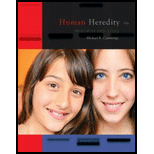
Can DNA profiling identify the source of a sample with absolute certainty? Because any two human genomes differ at about 3 million sites, no two persons (except identical twins) have the same DNA sequence. Unique identification with DNA profiling is therefore possible if enough sites of variation are examined. However, the systems used today examine only a few sites of variation. Nonetheless, even with today’s technology, which uses three to five loci, a match between two DNA patterns can be considered strong evidence that the two samples came from the same source.
DNA profiling in criminal cases has been a useful tool in establishing both guilt and innocence. Originally, DNA databases contained only the profiles of convicted felons. Over time, however, law enforcement agencies have expanded the collection and use of DNA profiles, and these new policies are causing controversies, once again illustrating how the availability and use of genetic technology is often ahead of consensus on how and when this technology should be used. One of these new policies is postarrest DNA collection.
At this writing, 18 U.S. states as well as the federal government allow the collection of DNA samples after an arrest but before conviction. These profiles become part of the state’s DNA database, which is often searched for evidence in cold cases. Courts across the country have ruled for and against the use of such samples.
In 2012, the Maryland Court of Appeals ruled that the collection of DNA samples from someone who has been arrested but not convicted is unconstitutional and violates an individual’s right to be free from unreasonable search and seizure. The case began when a DNA sample was taken from Alonzo Jay King, Jr., who was arrested in 2009 for assault. In a database search, the DNA profile matched that taken from a 2003 unsolved rape. Based on the results of the database search, the man was sentenced to life in prison. The rape conviction was reversed, and the case was sent back to a lower court. As a result, some 16,000 DNA profiles collected postarrest but preconviction since 2009 cannot be used pending appeal of this decision. Before the court decision, postarrest DNA profiles were used in 65 arrests that resulted in 34 convictions, with an additional 12 cases pending.
Supporters of postarrest DNA profiling claim that taking a DNA sample by a cheek swab is noninvasive and no different from taking someone’s fingerprints. Opponents claim that because DNA samples can be used to determine much more than a DNA profile, they are a threat to privacy, and that because minorities are more likely to be arrested, the practice is discriminatory.
What if you learned that law enforcement officials were saving the DNA sample for use in tests that might be developed in the future?
Want to see the full answer?
Check out a sample textbook solution
Chapter 14 Solutions
Human Heredity: Principles and Issues (MindTap Course List)
- 9 S es Read the section "Investigating Life: In (Extremely) Cold Blood." Then, drag and drop the terms on the left to complete the concept map. Red blood cells Genes Icefishes -have mutated have colorless Oxygen have few lack encode Blood Cellular respiration consists of- contain carries is a Platelets White blood cells carries low amounts of Hemoglobin is necessary for Plasma Protein Reset.arrow_forwardPlating 50 microliters of a sample diluted by a factor of 10-6 produced 91 colonies. What was the originalcell density (CFU/ml) in the sample?arrow_forwardEvery tutor here has got this wrong, don't copy off them.arrow_forward
- Suppose that the population from question #1 (data is in table below) is experiencing inbreeding depression (F=.25) (and no longer experiencing natural selection). Calculate the new expected genotype frequencies (f) in this population after one round of inbreeding. Please round to 3 decimal places. Genotype Adh Adh Number of Flies 595 Adh Adh 310 Adhs Adhs 95 Total 1000 fladh Adh- flAdn Adh fAdhs Adharrow_forwardWhich of the following best describes why it is difficult to develop antiviral drugs? Explain why. A. antiviral drugs are very difficult to develop andhave no side effects B. viruses are difficult to target because they usethe host cell’s enzymes and ribosomes tometabolize and replicate C. viruses are too small to be targeted by drugs D. viral infections usually clear up on their ownwith no problemsarrow_forwardThis question has 3 parts (A, B, & C), and is under the subject of Nutrition. Thank you!arrow_forward
- They got this question wrong the 2 previous times I uploaded it here, please make sure it's correvct this time.arrow_forwardThis question has multiple parts (A, B & C), and under the subject of Nutrition. Thank you!arrow_forwardCalculate the CFU/ml of a urine sample if 138 E. coli colonies were counted on a Nutrient Agar Plate when0.5 mls were plated on the NA plate from a 10-9 dilution tube. You must highlight and express your answerin scientific notatioarrow_forward
 Human Heredity: Principles and Issues (MindTap Co...BiologyISBN:9781305251052Author:Michael CummingsPublisher:Cengage Learning
Human Heredity: Principles and Issues (MindTap Co...BiologyISBN:9781305251052Author:Michael CummingsPublisher:Cengage Learning Biology Today and Tomorrow without Physiology (Mi...BiologyISBN:9781305117396Author:Cecie Starr, Christine Evers, Lisa StarrPublisher:Cengage Learning
Biology Today and Tomorrow without Physiology (Mi...BiologyISBN:9781305117396Author:Cecie Starr, Christine Evers, Lisa StarrPublisher:Cengage Learning Biology: The Dynamic Science (MindTap Course List)BiologyISBN:9781305389892Author:Peter J. Russell, Paul E. Hertz, Beverly McMillanPublisher:Cengage Learning
Biology: The Dynamic Science (MindTap Course List)BiologyISBN:9781305389892Author:Peter J. Russell, Paul E. Hertz, Beverly McMillanPublisher:Cengage Learning Concepts of BiologyBiologyISBN:9781938168116Author:Samantha Fowler, Rebecca Roush, James WisePublisher:OpenStax College
Concepts of BiologyBiologyISBN:9781938168116Author:Samantha Fowler, Rebecca Roush, James WisePublisher:OpenStax College Principles Of Radiographic Imaging: An Art And A ...Health & NutritionISBN:9781337711067Author:Richard R. Carlton, Arlene M. Adler, Vesna BalacPublisher:Cengage Learning
Principles Of Radiographic Imaging: An Art And A ...Health & NutritionISBN:9781337711067Author:Richard R. Carlton, Arlene M. Adler, Vesna BalacPublisher:Cengage Learning





